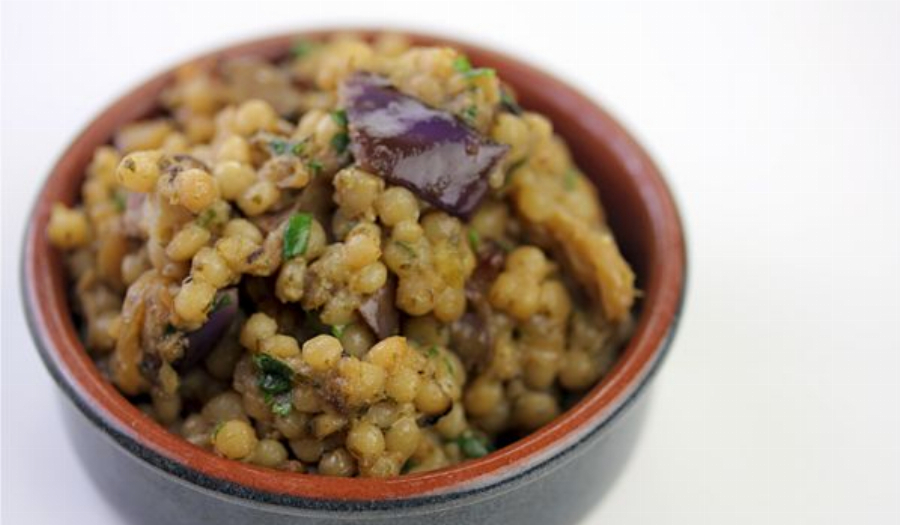I don’t often cook with toasted Israeli couscous. It’s not because it’s complicated to prepare, it’s just that it’s not a very common ingredient to find at the market. I personally like it because it can simply be boiled and serve as a side dish. I flavored it with puréed Japanese eggplant and a bright, sweet and tasty pistachio pesto.
I served the warm, green Israeli couscous with veal scallopini, which was absolutely delicious. There was some extra pistachio pesto, which I stored in the freezer for future use. I don’t know what I’m going to cook it with, but I can tell it will be scrumptious!
1. Info for Eggplant Israeli Couscous with Pistachio Pesto
- Cook Time: 15 mins
- Total Time: 45 mins
- Servings: 6
- Calories: 485kcal
2. Ingredients for Eggplant Israeli Couscous with Pistachio Pesto
- 3 cups Israeli toasted couscous
- ½ cup olive oil
- 1 clove garlic, finely minced
- 2 shallots, finely chopped
- ¼ cup pistachio kernels, coarsely crushed
- 2 large Japanese eggplants
- ½ teaspoon paprika
- 2 tablespoons cream cheese (optional), at room temperature
- 6 tablespoons Parmesan cheese, freshly grated
- 2 tablespoons unsalted butter
- 1 teaspoon black pepper, freshly cracked
- 1-½ tablespoons salt
- 6 tablespoons flat leaf parsley, chopped
3. Directions:
- For the eggplant pulp: Preheat your oven to 450°F. Slice the eggplants in half lengthwise. Layer a cooling rack on top of a cookie sheet, then place the eggplant slices on top. Sprinkle with salt and set the eggplant aside for about 30 minutes. Pat dry with a kitchen towel. Place the 2 pieces of eggplant flesh side down on a greased baking sheet. Drizzle the top with a little oil. Bake the eggplant for about 15-20 minutes. The skin should be black and blistered. Remove from the oven and cover with aluminum foil. Let the eggplant cool for about 10 minutes. Gather all the pulp of the eggplant and finely chop into a thick paste.
- For the pistachio pesto: In a blender (or a mini-food prep if you have one), combine ¼ cup parsley, 1 clove of garlic, pistachios, Parmesan cheese and 6 tablespoons olive oil. You might want to add about 2 tablespoons (or more) of water for a smooth flow. Season with salt and pepper. Set aside.
- How to caramelize shallots: Heat 2 tablespoons of oil in a non-stick pan. Add the shallots. Cook over medium-low heat for about 10-15 minutes, stirring frequently to prevent the onion from burning, until the color is evenly golden brown. Transfer to a plate, leaving as much oi as possible in the pan. To save time, I often have already-caramelized shallots (or onions) on hand in the freezer. I suggest making them in advance in large batches.
- Cooking Israeli couscous: Bring about 2 quarts of water to a boil. Add the couscous, bring back to a boil, then immediately lower the heat to a gentle boil. Cook the grains for about 10 minutes. Season with salt and continue cooking for an additional 5-8 minutes. Keep stirring every now and then so it doesn’t stick to the bottom. When the couscous is cooked (cooked inside and out but still in shape and firm), reserve about 2 to 2-½ cups of the liquid and drain it. Transfer to a large serving bowl.
- Assembly time: In the same non-stick pan, heat the reserved olive oil. Add the remaining garlic and cook until golden and fragrant. Add the cooked Israeli couscous and toss for about 2 minutes. If the couscous starts sticking to the bottom, add a little reserved water. Add the caramelized shallots, cream cheese (if used), paprika and eggplant pulp. Season with salt and pepper. Stir well. Turn off the heat and add the pistachio pesto. Mix until the couscous is well coated. Check seasoning. Add more salt if necessary.
- Sprinkle with parsley and the rest of Parmesan cheese. Let sit for about 5 minutes.
- Accompany with white meat and grilled vegetables. Bon appétit!

